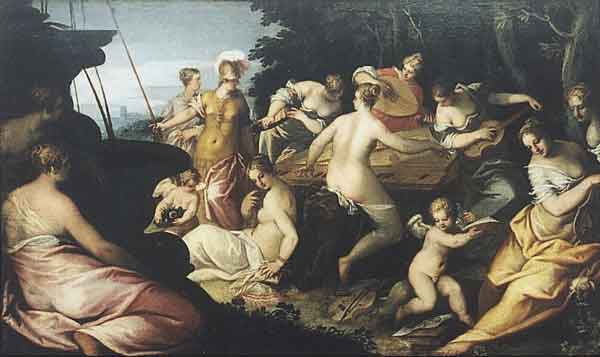|
|
Minerva and the Muses, by Hans Rottenhammer (1603). Minerva was a Roman goddess of crafts and wisdom. This article focuses on Minerva in early Rome and in cultic practice. For information on mythological accounts of Minerva, which were heavily influenced by Greek mythology, see Athena. Titles and roles The name "Minerva" may come from the Indo-European root *men-, from which "mental" and "mind" are also derived. However, the non-Indo-European speaking Etruscans had a goddess Menrva, so the name may be of entirely unknown derivation. Minerva was the daughter of Jupiter and Metis. She was considered to be the virgin goddess of warriors, poetry, medicine, wisdom, commerce, crafts, and the inventor of music. As Minerva Medica, she was the goddess of medicine and doctors. Adapting Greek myths about Athena, Romans said that Minerva was not born in the usual way, but rather sprang fully armed from the brain of her father; this image has captivated Western writers and artists through the ages. Worship Ovid called her the "goddess of a thousand works." Minerva was worshipped throughout Italy, though only in Rome did she take on a warlike character. Minerva is usually depicted wearing a coat of mail and a helmet, and carrying a spear. The Romans celebrated her festival from March 19 to 23 during the day which is called, in the feminine plural, Quinquatria, the fifth after the Ides of March, the nineteenth, the artisans' holiday. A lesser version, the Minusculae Quinquatria, was held on the Ides of June, June 13, by the flute-players, who were particularly useful to religion. Minerva was worshipped on the Capitoline Hill as one of the Capitoline Triad along with Jupiter and Juno. In 207 BC, a guild of poets and actors was formed to meet and make votive offerings at the temple of Minerva on the Aventine hill. Among others, its members included Livius Andronicus. The Aventine sanctuary of Minerva continued to be an important center of the arts for much of the middle Roman Republic. In Plutarch's Lives: Pericles; Minerva appears to Pericles in a dream and orders a course of treatment for an injured citizen of Athens. The treatment cured the man and a brass statue was erected in honor of Minerva Minerva in the modern world
Retrieved from "http://en.wikipedia.org/" All text is available under the terms of the GNU Free Documentation License
|
|
||||||||||||
